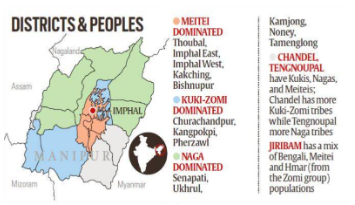

30th May 2023 (6 Topics)
Context
According to the Manipuri government, security forces recently killed 40 insurgents.
About
History of conflict in Manipur
- Naga National Movement: Manipur has been in the cross-currents of India’s oldest insurgent movements, such as the Naga national movement in the 1950s and the fight for an independent Nagalim.
- In 1964, the United National Liberation Front (UNLF) was formed, demanding secession from India.
- Meitei insurgent groups: Subsequently, numerous Meitei insurgent groups, such as the People’s Revolutionary Party of Kangleipak (PREPAK) and the People’s Liberation Army (PLA), came into being.
- Conflict between Meiteis and Meitei Pangals (Muslims): At the same time, similar clashes were taking place between the Meiteis and Meitei Pangals (Muslims), leading to the formation of the Islamist group People’s United Liberation Front, alongside several others.
- Kuki-Zomi insurgent groups: The Kuki-Zomi movement started as defence against aggression by other groups, but quickly morphed into a call for Kukiland - an imagined country spreading across the Kuki-Zomi inhabited areas of India, Myanmar and Bangladesh.
- The groups were a reaction to Naga aggression against the Kukis, and in 1993, a massacre of Kukis by the NSCN-IM left thousands of Kukis homeless.
- The primary groups in the area include the Kuki National Organisation and its armed wing, the Kuki Revolutionary Army, the Zomi Re-Unification Organisation, Zomi Revolutionary Army, the Kuki National Front, the Kuki National Liberation Front, United Kuki Liberation Front and Kuki National Army.
Steps taken by the Government in this regard:
- Enactment of AFSPA: The Indian government enacted the Armed Forces Special Powers Act in 1958 in response to Naga separatist activity.
- It was extended to the entire state in the 1980s, and peace talks led to a tripartite Suspension of Operation agreement between the Centre, the state and the Kuki-Zomi groups in 2008.
- However, the Valley Insurgent Groups have never entered an agreement with the Centre or participated in any peace talks, and technically remain active.
- At present, these groups are no longer active in the region.
|
More Articles



